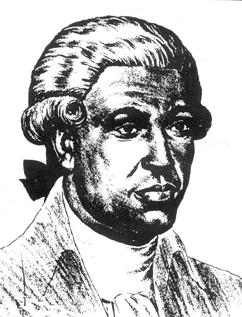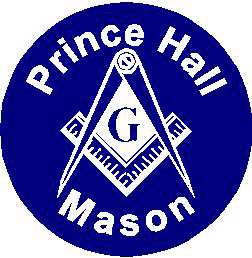 Prince Hall Freemasonry, traditionally called “Black” Freemasonry by some, is of direct lineage from the Grand Lodge of England (1717).
Prince Hall Freemasonry, traditionally called “Black” Freemasonry by some, is of direct lineage from the Grand Lodge of England (1717).
The Lodge that Prince Hall and the 14 others were made a Mason in was Lodge No. 441under the Irish Constitution. 1784 is the year that Bro. Hall requested and received a charter from the Grand Lodge of England, making African Lodge No. 459 a subordinate lodge to the Grand Lodge of England.
African Grand Lodge existed until 1847-48, at which time it’s name was changed to the MWPHGL of MA. This is the first recorded instance of his name being used in the GL title. (Thanks to Br. Lilly from the MWPHGL of NC for the keen eye and correction) More on Prince Hall Freemasonry on Wikipedia.
A very good biography on Prince Hall, gives a snapshot of the father of Black Freemasonry. Prince Hall died in 1807 at the age of 72. A year later, his lodge honored him by changing its name to Prince Hall Grand Lodge.
Prince Hall Freemasonry is nearly as widespread as “regular” Freemasonry in the United States. It has grown within many communities as a social institution with a very large following in many cities. The separation of Prince Hall and Regular Freemasonry in America is likely an out-cropping of early ideas of slavery in America, which carried into the Jim Crow laws of the early 20th Century. The backward ideas of separation and unequally, like many institutions, pervaded Freemasonry too, and continued the ideas of separate but equal. With the passage of time, and the implementation of the Plessy vs. Ferguson ruling, the ideas of mixed race meetings and membership has been slow in coming, but it is changing. In-roads were made to visit one another and relations were established.
 Today, as the barriers continue to be torn down, the further integration of Prince Hall and regular Freemasonry continues. Granting a full charter in 1996, the Grand Lodge of England finally resolved all the roadblocks for full recognition. All regular state Grand Lodges have eradicated all prohibitions to membership from men of all races, making them open to men of all colors, creeds, and outlook. The only requirement being a proclaimed faith in God. There may be still some apprehension (from both sides) to openly admit that there has been some willing separation, but the invisible walls that have kept many apart are beginning to evaporate.
Today, as the barriers continue to be torn down, the further integration of Prince Hall and regular Freemasonry continues. Granting a full charter in 1996, the Grand Lodge of England finally resolved all the roadblocks for full recognition. All regular state Grand Lodges have eradicated all prohibitions to membership from men of all races, making them open to men of all colors, creeds, and outlook. The only requirement being a proclaimed faith in God. There may be still some apprehension (from both sides) to openly admit that there has been some willing separation, but the invisible walls that have kept many apart are beginning to evaporate.
One of the biggest roadblocks to recognition is ritual differences and practices within a lodge. Freemasonry, being very firm on it’s ritual and it’s conduct, varies from state to state and jurisdiction to jurisdiction, so recognition is spotty across the board, but firm locally. Here is a great link to recognition between states.
So what does that mean. Looking at Freemasonry as a whole, it is not a racially biased institution. In my state California, there is full recognition of Prince Hall Freemasonry as being “regular” as decided though Grand Lodge legislation in 1995. Mutual recognition was agreed upon that year “completing the circle that Prince Hall started in 1784.”
There are states that have not reached that same conclusion for their own reasons, none of which I can proclaim knowledge of here. However both Freemasonry and Prince Hall Freemasonry are open to men of all races and welcomes them to share their light. Racism is not tolerated within the body of Freemasonry.
I use this as a preamble to a video published by Masonic Awareness at the Speed of Light. In the video, Charles M. Harper, Sr. introduces and talks about his book, Freemasonry in Black and White which explores the difference between recognition and amity within the confines of Freemasonry – essentially separate but equal bodies coexisting at common cause.
Freemasonry in Black and White from WEOFM on Vimeo.
presented by Charles M. Harper, Sr.
July 25, 2013
More videos are available at Masonic Awareness at the Speed of Light which is the world’s first exclusive Masonic Video Library, for the Masonic Craft and other interested parties.
What do you think? Is amity the same as recognition?

I applaud the effort of the writer but ask that all facts be checked before going to publish and being disseminated to the masses.
The Lodge that Prince Hall and the 14 others were made a Mason in was Lodge No. 441under the Irish Constitution. 1784 is the year that Bro. Hall requested and received a charter from the Grand Lodge of England, making African Lodge No. 459 a subordinate lodge to the Grand Lodge of England.
African Grand Lodge existed until 1847-48, at which time it’s name was changed to the MWPHGL of MA. This is the first recorded instance of his name being used in the GL title.
Bro. Lilly
A.S. Hunter Lodge No. 825
MWPHGL of NC
Thanks for the catch. I’ve amended it as such.
Excellent article!
Bro Milliken…I have a question….Since you are challenging the information contained in the video…what information do you have to say otherwise?
PM Curtis Black
James E. Carter #157
MWPHGLOTX and it’s Jurisdiction